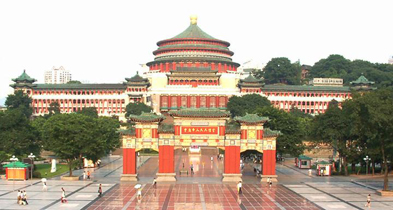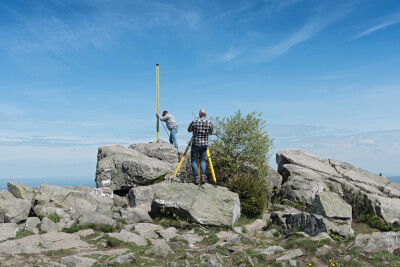The Chongqing People’s Great Hall is a building complex located in the city of Chongqing in southwest China. Although traditional in style, it was designed in 1950 and constructed from 1950 to 1954. At the start of a renovation project in 2006, “the building was barely more than fifty years old, but they didn’t have any of the original drawings,” says Zhong Chen, president of Dynasty Group, Inc., Chicago, and general manager of Beijing Dynasty Digital Technology, Ltd., Beijing. “So the Administration Office of the People’s Great Hall of Chongqing hired our Beijing firm to document the whole structure with 3D laser scanning.” The two firms provide consulting engineering and land surveying services, and specialize in transportation, historic preservation and industrial plants. Dynasty Group has used laser scanning since 2001.
“The management group in charge of this project wanted to document the building completely,” Chen explains, both to aid the renovation and “just in case anything major happened during construction.” The group “had seen some laser scanning work we did previously in the Forbidden City and other parts of China, and liked it.” Other surveyors had already documented some of the structure before Dynasty was called in, Chen reports, “but with traditional methods, it was just impossible to capture everything” given the amount of detail, and the building’s sheer size. One of the largest public assembly buildings in China, the complex is 65m tall at its highest point, 160m wide, and able to hold more than 4000 people.
Value of laser scanning for historic preservation
A prime benefit of laser scanning for historic preservation is “the accuracy of the data,” Chen emphasizes. “One thing I’ve experienced, not on this building but on others with a few hundred years of history behind them,” is that historically trained architects can look at a digital 3D model of the structure “and tell right away, just by eye, whether the model is right or wrong” – whether relationships between different building members are accurate, for instance. Basing models on laser scan data is a boon for accuracy in historic recordation, Chen says.
Does using laser scanning instead of conventional measurement make economic sense in low-cost labor areas? Chen says yes – the quality and completeness of data produced by laser scanning can be uneconomical, even impossible, to achieve any other way. Further, “in doing this kind of work in China, the low cost of labor” means that even extensive, whole-building laser scanning projects such as this one are economically feasible despite limited budgets and short schedules.
Continued
Scanning Chongqing People’s Great Hall – unique challenges
Chen notes how unusual this structure is, especially for its time. “The Communist Party took over China in 1949,” he observes, “and to build something like this just one year after the liberation was remarkable – especially since it was not in Beijing, but pretty far away. Some of the older generation told me how the project was quite controversial at the time, because of the possibility that the government in Beijing – or Chairman Mao – might not like it. But the people managing that region of the country wanted something big” where large assemblies could be held.
The Main Hall (Figure 1 – cylindrical structure at center; Figure 2 – dome and hall interior) was designed to resemble the Temple of Heaven in Beijing, while the central part of the building (Figure 1 – elevated forecourt in front of Main Hall) is a reproduction of Beijing’s Tian An Men – the Gate of Heavenly Peace. “One interesting thing about this structure is that the first five floors are made of concrete,” Chen adds. “Then, supporting the dome is a steel structure. And at the top of the dome, to support the three-layer roof, there’s a timber structure. So the building is very much a combination of materials.”
Scanning a structure of this size and complexity was not a quick job. “We spent exactly one month on site,” Chen says. “I couldn’t believe it – I had a 31-day hotel bill at the end of it!” The scanning team varied from Chen and two Beijing Dynasty Digital Technology employees, to Chen and four employees at the peak, plus another crew member taking digital photos. In all, the team executed some 350 scans, “using mostly our HDS2500,” Chen says – the last job on which it used this instrument before purchasing Leica ScanStations. “On average we were shooting for 1cm accuracy, so we had to do a lot of shooting, and a lot of targeting.” In addition, the crew used conventional survey to establish a control network.
Data collection took place from July 24 to August 23, 2006, when daytime temperatures averaged 39deg C – about 102deg F. To escape the heat, sometimes the scan team would stop work during the day and resume at night.
Continued
Data deliverables
Back at Beijing Dynasty Digital Technology’s office, scan data was registered and processed in Cyclone. To aid dimensional accuracy, “we decided to model the columns and major beams in Cyclone, then export the models to CAD,” Chen reports. 2D plan, section and elevation drawings were created based on point-cloud data, while visually realistic 3D models were generated in 3D Studio MAX. “Three or four people spent a good two to two and a half months to create the drawings,” Chen says. “Modeling was another three to four people working for two months.”
Continued
Laser scanning’s value for People’s Great Hall project
In sum, what value did laser scanning deliver for the Chongqing People’s Great Hall project? “One, obviously, is coming up with the 2D architectural and engineering drawings,” Chen says. Also of high value was the ability to create a dimensionally accurate 3D model, then drape digital photograph data to create a high-visual-fidelity model – this was a payoff of the thousands of digital photographs the Beijing Digital Dynasty Technology team took in order to capture details such as the paintings on columns and beams. Finally, having a complete point cloud of the entire complex means that additional detail drawings could be developed as needed based on the scan data, without revisiting the site.






